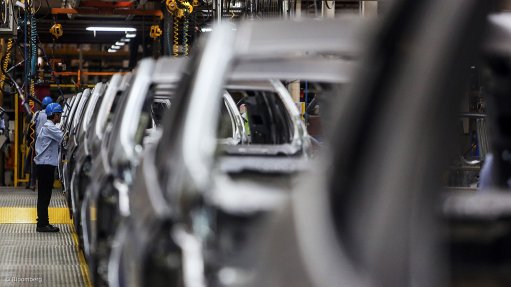
ASSEMBLY LINE
Growth is expected in South Africa’s motor vehicle manufacturing industry
Photo by: Bloomberg
The outlook for the South African motor vehicle manufacturing industry in 2015 is modestly positive, with an expected marginal volume increase of up to 3% in domestic sales, says National Association of Automobile Manufacturers of South Africa director Nico Vermeulen.
This is mainly based on projections of a slight improvement in the country’s economic growth rate of about 2%, with relatively stable industrial relations in the automotive industry and moderating consumer price inflation, as well as stable interest rates and credit ratings, being the other factors.
Vermeulen says the aggregate industry employment level for the fourth quarter of last year, as at December 31, totalled 30 466. This number represents the number of people employed by the country’s new-vehicle manu- facturing industry, comprising light-vehicle manufacturers and specialist truck and bus manufacturers.
He adds that the substantial increase in the employment rate is related to the higher levels of vehicle production during the fourth quarter of last year and expected growth in vehicle output in 2015.
Vermeulen further notes that various manufacturers operate double shifts in selected areas such as machining, and in press, paint and body shops.
Meanwhile, on a year-on-year comparative basis, the consumer-driven new-car market continues to experience pressure, while the investment-led vehicle sectors, particularly light and heavy commercial vehicles, driven by investments from big companies and organisations increasing their company fleets, reflect positive improvements.
Vermeulen adds that, while global new-vehicle production reached 89.75-million vehicles last year, South Africa’s vehicle production showed a marginal increase, from 545 913 units produced in 2013 to 566 083 vehicles last year. “A substantial increase in new-vehicle production is antici- pated for 2015, with industry output projected to reach 630 000 vehicles.”
Components and Materials
Vermeulen notes that the availability and supply of imported original-equipment components during the fourth quarter of last year was generally positive. He says the prices of imported components in foreign currency remained stable, with oil-based components reducing in price.
He adds that the availability of imported raw materials also remained satisfactory last year and that lower oil-based new materials are expected to reduce the cost of tyres, resins and lubricants this year. He further highlights a drop in the price of materials such as natural rubber and steel.
Meanwhile, last year’s availability and supply of locally produced components were also satisfactory. However, Vermeulen says the supply of plastic parts, forgings and chromed badges was constrained.
He says local component prices were generally stable, but that imported content in locally produced components was affected by depreciation in the exchange rate.
Vermeulen adds that the price fluctuations of local raw materials in 2014 were also affected by the exchange rate and commodity price movements. During the fourth quarter, lead and aluminium prices increased, while steel prices decreased.
Capital Expenditure
The automotive manufacturing industry’s aggregate capital expenditure for 2014 reflected a new record of R6.9-billion. “Relatively high levels of capital expenditure in recent and particularly future years might be attributed to manufacturers’ investment projects, in terms of the Automotive Production and Development Programme (APDP),” says Vermeulen.
The APDP supports South Africa’s automotive industry by promoting sector investment projects to enable the industry to become a sustainable global competitor with reduced reliance on government support. The APDP is intended to extend support to the automotive industry until 2020. The programme was established in 2013 and replaced its predecessor, the Motor Industry Development Programme.
Total domestic production, mostly owing to increased vehicle exports, is expected to increase by about 10% to about 625 000 vehicles this year, from 566 083 units produced in 2014.